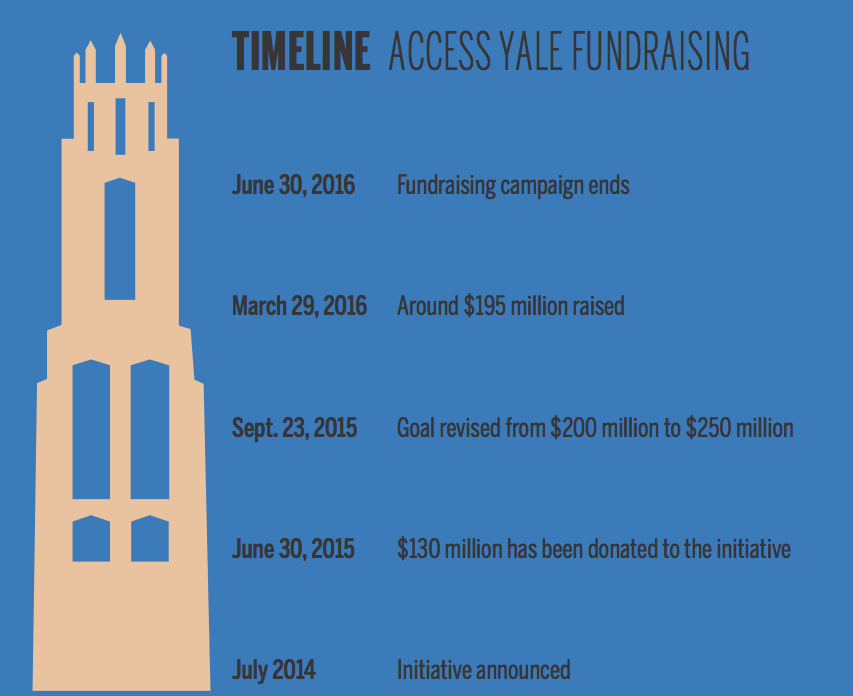
With three months until the completion of Access Yale, a two-year fundraising initiative to raise money for financial aid, the University is $55 million shy of its $250 million goal.
Following a strong first year in which Yale raised $130 million for the program, the Office of Development increased the overall goal from $200 million to $250 million. The initiative was launched in July 2014, partly in preparation for the 800 new students who will arrive over four years once the two new residential colleges open in 2017. According to a January YaleNews release, the new students will cost the University an additional $18 million per year in financial aid.
Just over half of the funds raised so far have been designated toward Yale College by their donors, with the rest directed toward the graduate and professional schools or the University more generally, according to Vice President for Alumni Affairs and Development Joan O’Neill. Though Yale still needs to raise just under a quarter of its total goal by June 30, O’Neill said she expects donations to spike in the weeks just before the end of the initiative.
“I am optimistic we will hit the [$250 million] by June 30, though it is going to be a push,” O’Neill said. “But we have a number of very good gifts in the pipeline, and several of them are donors in reunion years so they are motivated to finalize their commitments in time to have it count toward their class totals, and that’s a June 30 deadline … The reunions are kind of like mini campaigns.”
Ellen Lewis, senior director for marketing and communications at the Development Office, said that while the initiative was a focus at meetings with key volunteer groups during its first year, the initiative has maintained a presence on social media and other Yale websites throughout its duration. The first year’s total also included a bequest from the estate of Richard Urowsky ’67 LAW ’72, she added.
Amounts pledged by donors, but not necessarily given before the deadline, also count toward the $250 million.
The goal of the initiative is not only to expand access to Yale College, but also to provide graduate and professional school students with more aid. O’Neill said generous donations have been given to schools like Yale Law School, the Divinity School, the School of Nursing and the medical school, which, unlike Yale College, are not need-blind.
“[Unlike Yale College,] they’re trying to increase the amount of money they’re giving in financial aid,” O’Neill said. “They could get gifts that increase the amount they give, because they can’t always meet demonstrated need.”
However, given Yale’s $25.6 billion endowment, students have criticized the administration for years over its refusal to eliminate the student effort, an amount currently set at $6,400 per year that the nearly 3,000 undergraduates receiving need-based financial aid must contribute to their educations. That number is set to drop by $1,350 next year for students with the highest need and $450 for all other students.
When Director of Financial Aid Caesar Storlazzi ’75 MUS ’84 and Dean of Undergraduate Admissions Jeremiah Quinlan ’03 announced the decrease in December, they cited budget constraints as the reason why it could not be eliminated. Yet despite the increased funds that will be brought in by Access Yale, the financial aid office has not announced any change in policy.
Storlazzi declined to comment.
Administrators have emphasized in the past that a significant portion of Yale’s resources directed to financial aid are endowed funds that cannot be drawn on at will. The current budget for financial aid in Yale College is $122 million. That number will increase by $2 million starting in fall 2016 as a result of the decrease in the student effort.
Peter Huang ’18, who receives financial aid, said that while the initiative seeks to keep Yale affordable for students, it should also aim to improve students’ experiences while they are on campus.
“I understand that students across the country are also working to pay their way through college, but Yale has the resources and the ability to ensure that Yale undergraduates do not have to choose between paying for college and classes and extracurricular activities.”
If Yale wants students to be better able to pursue their aspirations after college, Huang said, they should be able to put more time and energy into laying a foundation for their aspirations while they are students.
Tyler Blackmon ’16, who co-authored a January 2015 Yale College Council report calling for the elimination of the student effort, said he hoped Yale would raise money for this purpose if it could not be eliminated due to budget constraints.
“I think it’s great that Yale will now be accessible to a greater number of low-income people in terms of raw numbers,” Blackmon said. “But there’s no reason why Yale cannot also continue to make progress for existing students by eliminating the student effort altogether.”
When Access Yale launched in January, Salovey told the News that financial aid policies are evaluated on an ongoing basis and are independent of the fundraising initiative.
O’Neill, too, said the purpose of Access Yale is to ensure the University remains able to support its current financial aid offerings, not to change the financial aid formula.
Last academic year, 41,582 alumni donated to the University.







